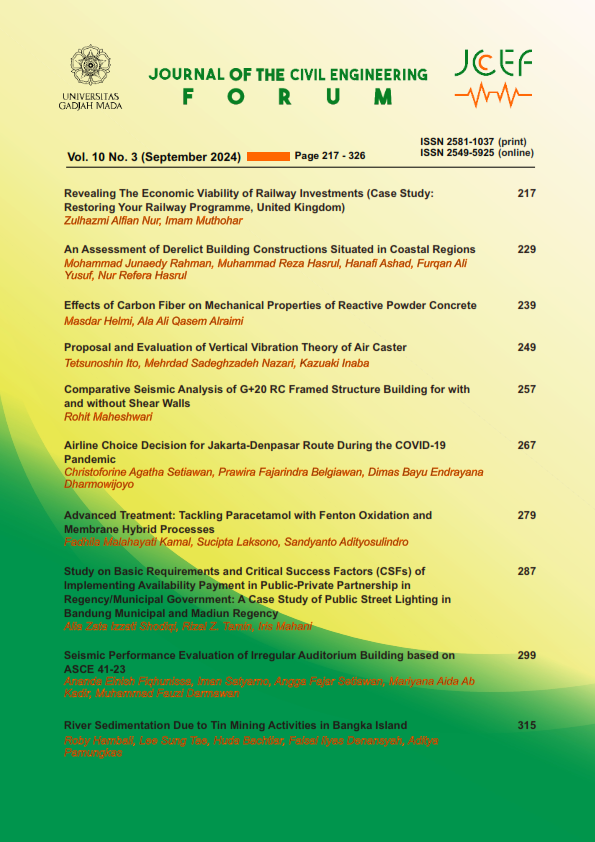Study on Basic Requirements and Critical Success Factors (CSFs) of Implementing Availability Payment in Public-Private Partnership in Regency/Municipal Government: A Case Study of Public Street Lighting in Bandung Municipal and Madiun Regency
Abstract
Referring to PPP Books 2017-2023 issued by The Ministry of National Development Planning of Indonesia, there is only 1 out of 16 AP PPP projects at the municipal/regency level that have successfully reached the operational stage (6% success rate), i.e. Madiun Regency Public Street Lighting. Several municipal/regency AP PPP projects have failed, for example, Bandung Municipal Public Street Lighting. The widespread failures indicate that the application of AP in regional infrastructure has so far not been successful in Indonesia. This paper aims to identify the basic requirements, critical success factors, and lessons learned from AP PPP implementation in Municipal/Regency Governments. Thus, it is hoped that the future provision of regional infrastructure with the AP scheme can proceed seamlessly. This study used a mixed-method approach that combines qualitative and quantitative data from literature reviews, questionnaires, and interviews. The results showed that the basic requirements for AP PPP include the existence of regulations and institutions. The five main success factors of AP PPP in the Municipal/Regency Government are (1) a well-organized and committed public agency; (2) political support; (3) favorable and efficient legal framework; (4) stable political and economic situation; and (5) public and private sector commitments and responsibilities. The lesson learned from the case study is that fiscal capacity is not the main factor in the success of PPP in Madiun Regency, but rather the willingness of the local government to implement PPP by regularly holding capacity building and maintaining good relationships and communication with each stakeholder involved.
References
Alias, Z. et al. (2014), ‘Determining critical success factors of project management practice: A conceptual framework’, Procedia – Social and Behavioral Sciences 153, 61–69. URL: http://doi.org/10.1016/j.sbspro.2014.10.041
Almarri, K. and Hijleh, B. A. (2016),‘Critical success factors for public private partnerships in the uae construction industry- a comparative analysis between the uae and the uk’, Journal of Engineering, Project, and Production Management 7(1), 21–32. URL: http://doi.org/10.32738/JEPPM.201701.0004
Babatunde, S. O., Opawole, A. and Akunsiku, O. (2012), ‘Critical success factors in public-private partnership (ppp) on infrastructure delivery in nigeria’, Journal of Facilities Management 10(3), 212–225. URL: http://doi.org/10.1108/14725961211246018
Chan, A. P. C. et al. (2010), ‘Critical success factors for ppps in infrastructure developments: Chinese perspective’, Journal of Construction Engineering and Management 136(5), 484–494. URL: https://doi.org/10.1061/(ASCE)CO.19437862.0000152
Cheung, E., Chan, A. P. C., Lam, P. T. I., Chan, D. W. M. and Ke, Y. (2012), ‘A comparative study of critical success factors for public private partnerships (ppp) between mainland china and the hong kong special administrative region’, Facilities 30(13/14), 647–666. URL: http://doi.org/10.1108/02632771211273132
Chou, J. S. and Pramudawardhani, D. (2015), ‘Crosscountry comparisons of key drivers, critical success factors and risk allocation for public-private partnership projects’, International Journal of Project Management 33, 1136–1150. URL: http://doi.org/10.1016/j.ijproman.2014.12.003
Chou, J. S., Tserng, H. P., Lin, C. and Yeh, C. P. (2012), ‘Critical factors and risk allocation for ppp policy: Comparison between hsr and general infrastructure projects’, Transport Policy 22, 36–48. URL: https://doi.org/10.1016/j.tranpol.2012.05.009
Dada, M. O. and Oladokun, M. G. (2022), ‘Critical success factors for public–private partnership projects in nigeria: A perceptual survey’.
Dulaimi, M. F. et al. (2010), ‘The execution of publicprivate partnership projects in the uae’, Construction Management and Economics 28(4), 393–402. URL: http://doi.org/10.1080/01446191003702492
Emmanuel, O. O. (2013), ‘Critical success factors (csf) determining the implementation of public-private partnership projects’, Covenant Journal of Research in the Built Environment (CJRBE) 1(2). URL:https://www.semanticscholar.org/paper/CRITICAL-SUCCESS-FACTORS-(-CSF-)-DETERMINING-THE-OF-Emmanuel/e7509676e42fc21aa769822b533e06e854b838c9?utm_source=direct_link
Hai, D. T., Toan, N. Q. and Tam, N. V. (2022), ‘Critical success factors for implementing ppp infrastructure projects in developing countries: the case of vietnam’, Innovative Infrastructure Solutions 7(1). URL: http://doi.org/10.1007/s41062-021-00688-6
Helmy, M. A. (2011), ‘Investigating the critical success factors for ppp projects in kuwait’.
Helmy, R., Khourshed, N., Wahba, M. and Bary, A. A. E. (2020),‘Exploring critical success factors for public private partnership case study: The educational sector in egypt’, Journal of Open Innovation Technology, Market, and Complexity 6(4), 142. URL: http://doi.org/10.3390/joitmc6040142
Hwang, B.-G., Zhao, X. and Gay, M. J. S.-Y. (2013), ‘Public private partnership projects in singapore: Factors, critical risks and preferred risk allocation from the perspective of contractors’, International Journal of Project Management 31, 424–433. URL: http://doi.org/10.1016/j.ijproman.2012.08.003
Ismail, S. (2013), ‘Critical success factors of public private partnership (ppp) implementation in malaysia’, Asia-Pacific Journal of Business Administration 5(1), 6–19. URL: http://doi.org/10.1108/17574321311304503
Jefferies, M., Gameson, R. and Rowlinson, S. (2002), ‘Critical success factors of the boot procurement system: reflections from the stadium australia case study’, Engineering, Construction and Architectural Management 9(4), 352–361. URL: http://doi.org/10.1108/eb021230
Kwak, Y. H., Chih, Y. Y. and Ibbs, C. W. (2009), ‘Towards a comprehensive understanding of public private partnership for infrastructure development’, California Management Review 51(2), 51–78. URL: http://doi.org/10.2307/41166480
Kyei, R. O. and Chan, A. P. (2017), ‘Empirical comparison of critical success factors for public-private partnerships in developing and developed countries: A case of ghana and hong kong’, Engineering, Construction and Architectural Management 24(6), 1222–1245. URL: http://doi.org/10.1108/ECAM-06-2016-0144
Lee, D. (2021), Critical success factors of the overseas ppp infrastructure project from the perspective of korea, Master’s thesis, KDI School of Public Policy and Management.
Li, B., Akintoye, A., Edwards, P. J. and Hardcastle, C. (2005), ‘Critical success factors for ppp/pfi projects in the uk construction industry’, Construction Management and Economics 23(5), 459–471. URL: http://doi.org/10.1080/01446190500041537
Mahani, I. (2018), Development of Non-Contingent Government Support for Toll Roads with the Supported Build Operate Transfer (SBOT) Scheme in Indonesia, PhD thesis, Institut Teknologi Bandung.
Mahani, I. et al. (2022), ‘A study on the application of availability payment scheme for urban infrastructure in indonesia’, International Journal of Education and Social Science Research 5(5), 91–104. URL: http://doi.org/10.37500/IJESSR.2022.5506
Maramis, J. B. (2018), ‘Faktor faktor sukses penerapan kpbu sebagai sumber pembiayaan infrastruktur: Suatu kajian’, Jurnal Manajemen Bisnis dan Inovasi 5(1), 49–63. URL: https://doi.org/10.35794/jmbi.v5i1.19149
Meyer, B. (2022), Requirements: basic concepts and definitions, in ‘Handbook of Requirements and Business Analysis’, Springer, Cham. URL: https://doi.org/10.1007/978-3-031-06739-61
Muhammad, Z. and Johar, F. (2018), ‘Coping with challenges of public-private partnership (ppp) for housing delivery in nigeria’, International Journal of Engineering Technology 7(2.29), 1097–1101. URL: https://doi.org/10.14419/ijet.v7i2.29.14320
Muhammad, Z. and Johar, F. (2019), ‘Public-private partnership for housing construction projects a comparative analysis of the success factors between malaysia and nigeria’, IOP Conference Series: Materials Science and Engineering 620(1), 012007. URL: http://doi.org/10.1088/1757-899X/620/1/012007
Muhammad, Z. et al. (2016),‘An overview of critical success factors of public private partnership in the delivery of urban infrastructure and services’, Planning Malaysia Journal 14(4), 147–162. URL: https://doi.org/10.21837/pm.v14i4.155
Natalia, L., Tanzil, N. D. and Sari, P. Y. (2021), ‘Critical success factors of public-private partnership from 2000 to 2019: A literature review’, Jurnal Perspektif Pembiayaan dan Pembangunan Daerah 8(6), 531–540. URL: https://doi.org/10.22437/ppd.v8i6.10742
Nguyen, P. T., Likhitruangsilp, V. and Onishi, M. (2017), ‘Success factors for public-private partnership infrastructure projects in vietnam’, International Journal on Advanced Science Engineering Information Technology 10(2), 858–865. URL: http://doi.org/10.18517/ijaseit.10.2.5839
Nguyen, P. V., Trieu, H. D. X., Do, M. A. and Nguyen, A. T. (2021), ‘Evaluating critical success factors in public–private partnership water supply infrastructure projects’, SHS Web of Conferences 129(2), 09012. URL: http://doi.org/10.1051/shsconf/202112909012
Qiao, L., Wang, S. P., Tiong, R. L. K. and Chan, T. S. (2001), ‘Framework for critical success factors of bot projects in china’, The Journal of Project Finance 7(1), 53–61. URL: http://doi.org/10.3905/jsf.2001.320244
Suhendra, M. and Satrio, P. B. (2020), ‘The key success factors of availability payment scheme implementation in the palapa ring western package ppp project’, International Journal of Scientific Technology Research 9(1), 851–859.
The Economist Intelligence Unit (2018),‘Evaluating the environment for public-private partnerships in asia: The 2018 infrascope’. URL: http://doi.org/10.1080/01446191003702492
Whardani (2021), Evaluation analysis of the implementation availability payment scheme for development infrastructure makassar–parepare railway, Master’s thesis, Institut Teknologi Bandung. URL: https://go.exlibris.link/BckDbwyw
Wibowo, A. and Alfen, H. W. (2015), ‘Government-led critical success factors in ppp infrastructure development’, Built Environment Project and Asset Management 5(1), 35–51. URL: http://doi.org/10.1108/BEPAM-03-2014-0016
Yusfida, I. (2022), ‘Critical success factor for labuhan bajo airport public-private partnership investment pilot project’, PENA TEKNIK: Jurnal Ilmiah Ilmu-Ilmu Teknik 7(1), 8–19. URL: http://doi.org/10.51557/pt_jiit.v7i1.1095
Zhang, X. (2005), ‘Critical success factors for public–private partnerships in infrastructure development’, Journal of Construction Engineering and Management 131(1), 3–14. URL: http://doi.org/10.1061/(ASCE)07339364(2005)131:1(3)
Copyright (c) 2024 The Author(s)

This work is licensed under a Creative Commons Attribution-ShareAlike 4.0 International License.
Copyright is granted to authors for the purpose of providing protection for articles written to describe experiments and their results. JCEF will protect and defend the work and reputation of the author and are also willing to address any allegations of violation, plagiarism, fraud, etc. against articles written and published by JCEF. JCEF is published under the terms of the Creative Commons Attribution-ShareAlike 4.0 International License (CC BY-SA 4.0). The author holds the copyright and assigns the journal rights to the first publication (online and print) of the work simultaneously.




